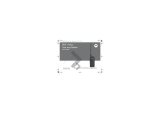
2
CONTENTS
Talk Range . . . . . . . . . . . . . . . . . . . . . . . . . .29
DLR and DTR Radios Compatibility . . . . . . .29
Radio Status . . . . . . . . . . . . . . . . . . . . . . . . .31
Advanced Configuration Mode . . . . . . . . .33
Entering Advanced Configuration Mode . . . .34
Browsing Advanced Configuration Options. .35
PROFILE ID Number . . . . . . . . . . . . . . .36
Maximum Channels . . . . . . . . . . . . . . . .40
Top Button . . . . . . . . . . . . . . . . . . . . . . .41
MIC Gain. . . . . . . . . . . . . . . . . . . . . . . . .43
Home Channel . . . . . . . . . . . . . . . . . . . .44
Resetting To Factory Defaults. . . . . . . . . . . .45
Radio Factory Default Settings . . . . . . . .46
Special Radio Call Features . . . . . . . . . . . .49
Private Reply. . . . . . . . . . . . . . . . . . . . . . . . .49
How Private Reply Works . . . . . . . . . . . .50
Private Reply Status Indicator. . . . . . . . .55
Direct Call . . . . . . . . . . . . . . . . . . . . . . . . . . .56
How Direct Call Works . . . . . . . . . . . . . .56
Direct Call Status Indicator . . . . . . . . . . .60
Call All Available . . . . . . . . . . . . . . . . . . . . . .64
How Call All Available Works . . . . . . . . .66
Call All Available Status Indicator . . . . . .72
Page All Available . . . . . . . . . . . . . . . . . . . . .73
How Page All Available works . . . . . . . .75
Page All Available Status Indicator . . . . 82
Customer Programming Software
(CPS) . . . . . . . . . . . . . . . . . . . . . . . . . . . . . . 83
CPS Basic Menu Instructions. . . . . . . . . . . . 84
Cloning . . . . . . . . . . . . . . . . . . . . . . . . . . . . 95
Cloning Radios. . . . . . . . . . . . . . . . . . . . . . . 95
Cloning Mode. . . . . . . . . . . . . . . . . . . . . 96
Cloning with a Multi-Unit Charger
(MUC) (Optional Accessory) . . . . . . . 97
Cloning Radio using the Radio to
Radio (R2R) Cloning Cable
(Optional Accessory) . . . . . . . . . . . . . 98
Wireless PROFILE ID Number
Cloning. . . . . . . . . . . . . . . . . . . . . . . 100
Cloning Mode Status Indicator . . . . . . . . . . 102
Troubleshooting. . . . . . . . . . . . . . . . . . . . 103
Use and Care . . . . . . . . . . . . . . . . . . . . . . 108
Motorola Limited Warranty for
the United States and Canada . . . . . . . . 109
Accessories . . . . . . . . . . . . . . . . . . . . . . . 113
Audio Accessories . . . . . . . . . . . . . . . . . . . 113
Battery . . . . . . . . . . . . . . . . . . . . . . . . . . . . 113
Cables . . . . . . . . . . . . . . . . . . . . . . . . . . . . 113
Chargers . . . . . . . . . . . . . . . . . . . . . . . . . . 113
Carry Accessories . . . . . . . . . . . . . . . . . . . 114




















